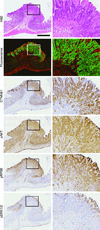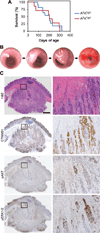Colon Tumors with the Simultaneous Induction of Driver Mutations in APC, KRAS, and PIK3CA Still Progress through the Adenoma-to-carcinoma Sequence
- PMID: 26276752
- PMCID: PMC4596777
- DOI: 10.1158/1940-6207.CAPR-15-0003
Colon Tumors with the Simultaneous Induction of Driver Mutations in APC, KRAS, and PIK3CA Still Progress through the Adenoma-to-carcinoma Sequence
Abstract
Human colorectal cancers often possess multiple mutations, including three to six driver mutations per tumor. The timing of when these mutations occur during tumor development and progression continues to be debated. More advanced lesions carry a greater number of driver mutations, indicating that colon tumors might progress from adenomas to carcinomas through the stepwise accumulation of mutations following tumor initiation. However, mutations that have been implicated in tumor progression have been identified in normal-appearing epithelial cells of the colon, leaving the possibility that these mutations might be present before the initiation of tumorigenesis. We utilized mouse models of colon cancer to investigate whether tumorigenesis still occurs through the adenoma-to-carcinoma sequence when multiple mutations are present at the time of tumor initiation. To create a model in which tumors could concomitantly possess mutations in Apc, Kras, and Pik3ca, we developed a novel minimally invasive technique to administer an adenovirus expressing Cre recombinase to a focal region of the colon. Here, we demonstrate that the presence of these additional driver mutations at the time of tumor initiation results in increased tumor multiplicity and an increased rate of progression to invasive adenocarcinomas. These cancers can even metastasize to retroperitoneal lymph nodes or the liver. However, despite having as many as three concomitant driver mutations at the time of initiation, these tumors still proceed through the adenoma-to-carcinoma sequence.
©2015 American Association for Cancer Research.
Conflict of interest statement
No conflicts of interest.
Figures






References
-
- American Cancer Society. Cancer Facts & Figures 2014. Atlanta: American Cancer Society; 2014.
-
- Nowell PC. The colonal evolution of tumor cell populations. Science. 1976;194:23–28. - PubMed
-
- Fearon ER, Vogelstein B. A genetic model for colorectal tumorigenesis. Cell. 1990;61:759–767. - PubMed
-
- Goss KH, Groden J. Biology of the adenomatous polyposis coli tumor suppressor. J Clin Oncol. 2000;18:1967–1979. - PubMed
-
- Kinzler KW, Vogelstein B. Cancer-susceptibility genes. Gatekeepers and caretakers. Nature. 1997;386:761–763. - PubMed
Publication types
MeSH terms
Substances
Grants and funding
LinkOut - more resources
Full Text Sources
Molecular Biology Databases
Miscellaneous

